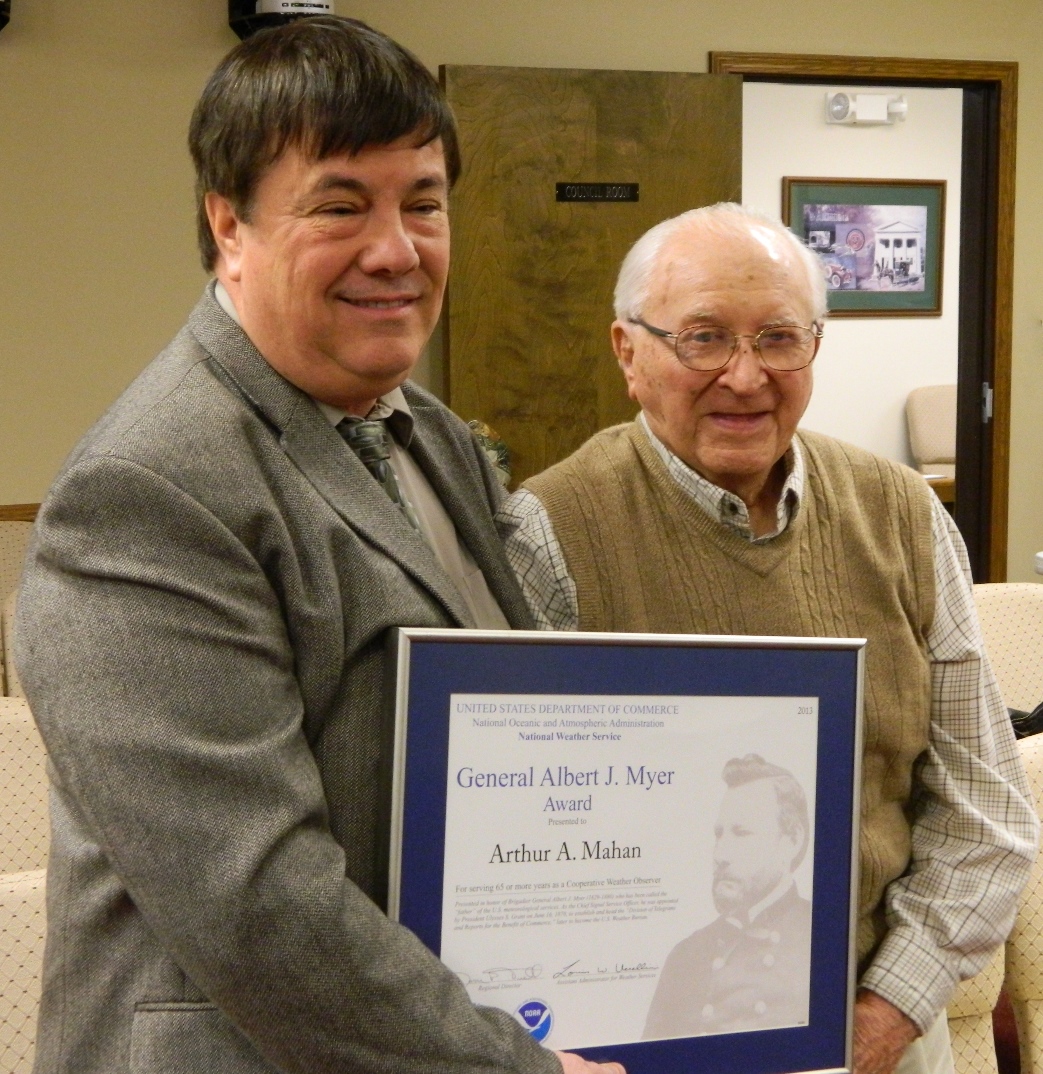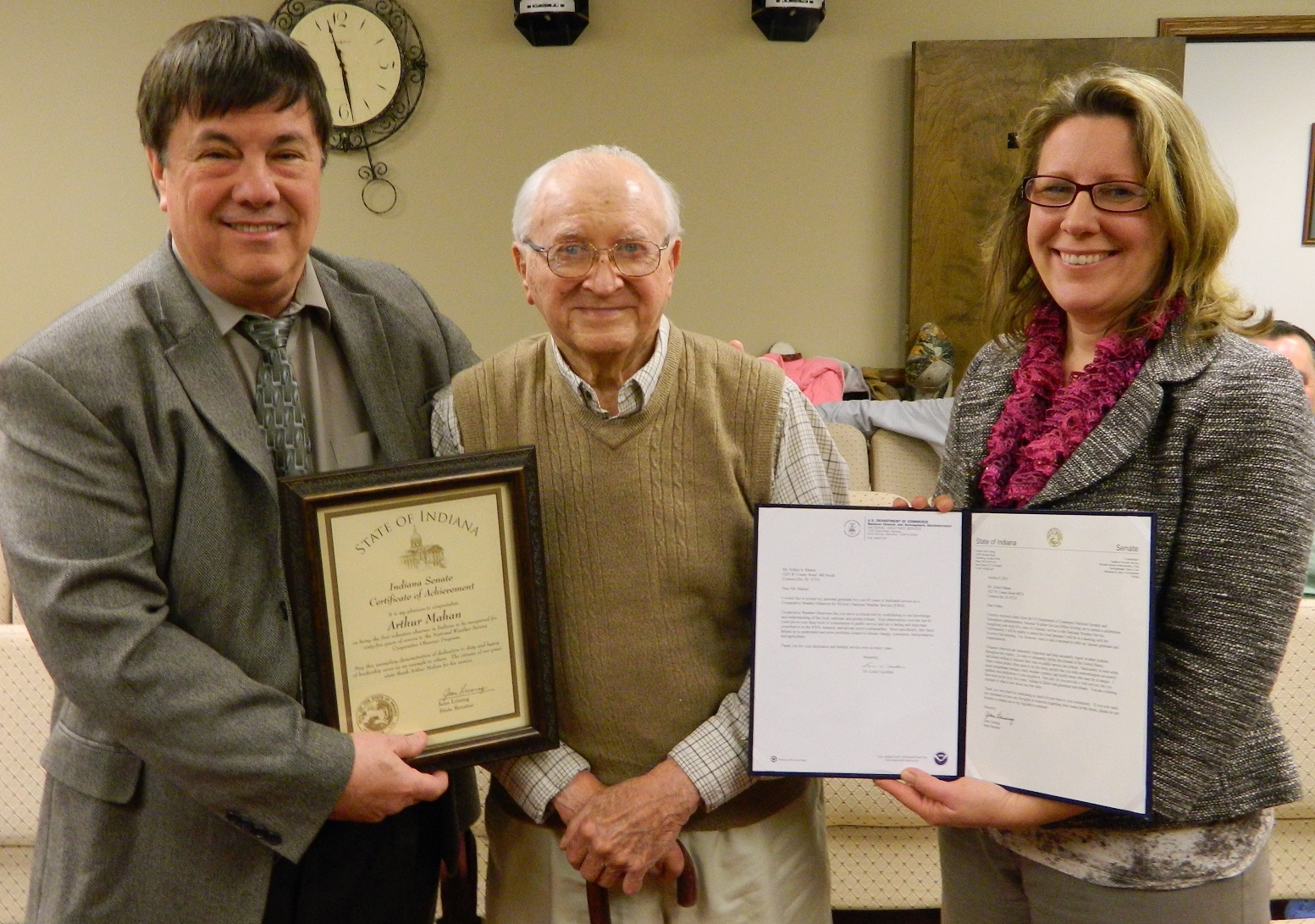This story was originally published in 2014 to highlight the outstanding service provided by NWS Cooperative Observer Mr. Arthur Mahan. Sadly, he passed away in 2016, but his kind personality and contributions to the United States' weather observation record will be long remembered.
On January 16, 2014, staff of NWS Wilmington, Ohio had the privilege of paying tribute to one of our long-time volunteer cooperative weather observers. Mr. Arthur Mahan of Alpine, Indiana has been recording precipitation data and submitting it to the National Weather Service for over 65 years! His outstanding record of observations began back in October 1948, when he first took over the duties and followed in his father's footsteps.
Mr. Mahan began taking observations back then with a weighing rain gauge that provided hourly precipitation data. The gauge consisted of a pen attached to a weighing instrument that marked a trace on a paper graph to indicate rainfall amounts. Mr. Mahan changed out the charts at least once a week and sent them to the National Climatic Data Center (NCDC) at the end of each month. In the 1960s, the weighing rain gauge was replaced by a Fischer Porter weighing rain gauge, which automatically punched holes in a roll of paper tape to indicate the amount of precipitation in the gauge. Mr. Mahan continued to change out the rolls of tape each month and send them to NCDC. For many years, he also reported Whitewater River levels at his location using a wire weight river gauge. These readings were used by the Ohio River Forecast Center, Army Corps of Engineers, and the USGS. An automated river gauge was eventually installed near his location, but Mr. Mahan reported river levels up until the year 2000.
 Mr. Mahan's original October 1948 monthly precipitation summary form. Mr. Mahan's original October 1948 monthly precipitation summary form.
For his long history of dedicated service to the National Weather Service, Mr. Mahan was presented the General Albert J. Myer award. This award was established in honor of General Myer, who is regarded as the father of today's National Weather Service, and it is presented to cooperative weather observers that complete 65 years of service. Over the past decade, only 24 cooperative observers nationwide have been presented this award. Mr. Mahan was one of only two observers to be honored for reaching this milestone in 2013, and he remains one of the longest serving NWS cooperative weather observers in Indiana history. We at the NWS proudly congratulate Mr. Mahan and thank him for his many years of honorable and dedicated service!
 |
 |
Meteorologist-in-Charge Ken Haydu and Service Hydrologist Julie Dian-Reed of NWS Wilmington, Ohio award Mr. Mahan for his many years of weather observations for the National Weather Service.
The National Weather Service Cooperative Observer Program is the nation's official weather and climate observing network, and it is truly of, by, and for the people. More than 11,000 volunteers take observations on farms, in urban and suburban areas, in national parks, by the seashore, and on mountaintops. The collected weather data is indeed representative of where people live, work, and play. The Cooperative Observer Program was formally created in 1890, and its mission is two-fold: first, to provide observational meteorological data required to define the climate of the United States and to help measure long-term climate changes; second, to provide observational meteorological data in near real-time to support forecast, warning, and other public service programs of the NWS.
Cooperative observers generally record temperatures and precipitation amounts daily, electronically sending their reports to the NWS and NCDC. Many cooperative observers also provide additional hydrological and meteorological data, such as soil temperatures and river levels. The roots of today's Cooperative Observer Program go all the way back to Thomas Jefferson, a dedicated weather observer who tried to enlist others in taking regular observations and who envisioned a national network of weather observers. Other notable weather observers from our nation's history include George Washington, whose last observation was taken the day before he died, and Benjamin Franklin. |
